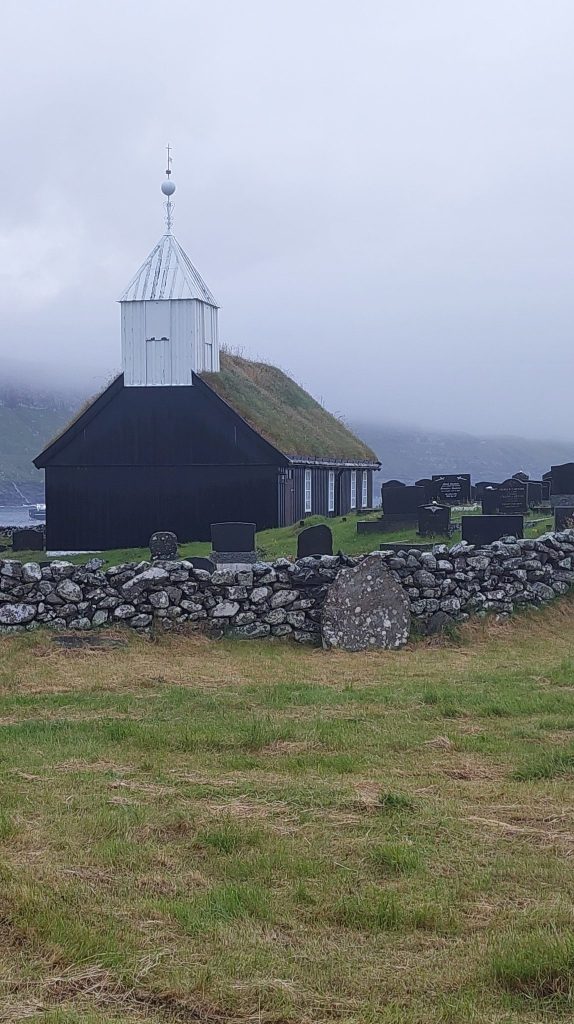Between Norway and Iceland, Tonality and Atonality

Between Norway and Iceland
To understand the musical offering of the 2024 ISCM World New Music Days (WNMD), you need to know the place and the people. It would be a mistake to think of this 11-day music marathon as an abstract contemporary music festival; everything here has its own shape and feel, given by the welcoming nature, tolerance, quirky humour and, in a way, provincialism of the Faroese. Provincialism is also about the good things, such as pride in one’s music, composers and players, because they belong to THEIR island. We really appreciated that ISCM delegates, composers, players had the opportunity to get to know the unique nature, the local culture and through that the warm hospitality of the islanders.
The Faroe Islands are an autonomous province of Denmark, an archipelago of islands located about halfway between Norway, Scotland, and Iceland. They have about 50 000 inhabitants, about the same number as the Latvian city Jelgava. The Faroe Islands are not part of the European Union, but there are no border controls when travelling between the Faroe Islands and any Schengen country. The Faroese archipelago consists of 18 islands, 17 of which are inhabited. Streymoy Island is home to the archipelago’s capital, Tórshavn, which is also the largest city. Its name is linked to the great Norse god Thor, after whom the harbour was named – Tórshavn (havn – harbour).
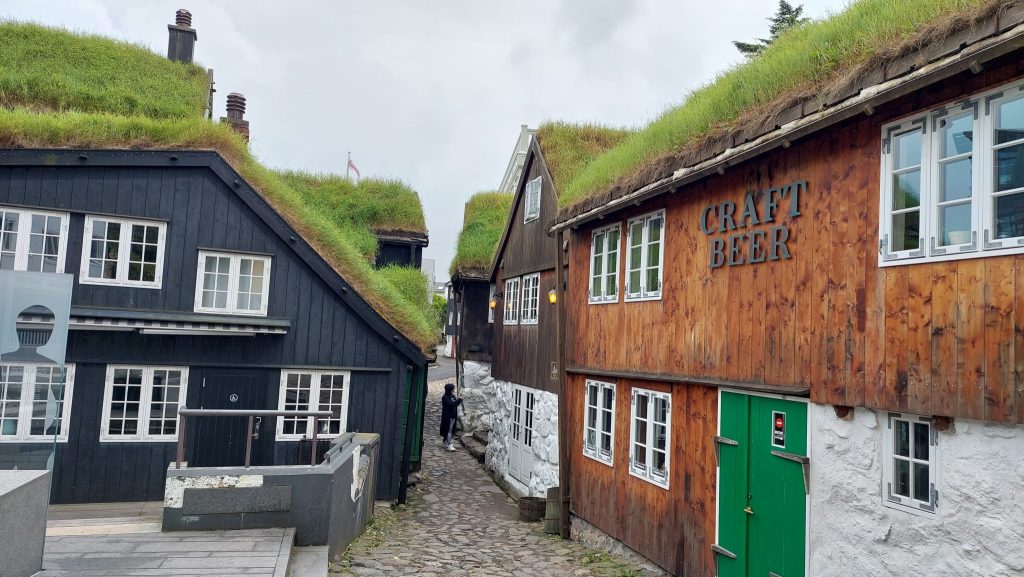
Most areas are managed autonomously by the Faroese; defense, police, justice, money, and foreign affairs being the sectors that Denmark looks after. The Faroes have their own Minister for Culture, whom we met at the opening concert. Her extended speech was proportionate to the generous support for culture, including the ISCM festival.
Someone mentioned that there is no prison on the island, but there is a hill-top cottage with three well-appointed rooms, because a person who has done something wrong is most likely unwell himself, so he must be provided with comfort and well-being, at least for a few days. This happens only a few times a year, and those who are incarcerated are transported to Denmark. In addition, all kinds of events are covered in detail on the local radio – important news, quarrels, and WNMD festival concerts.
Since the Faroe Islands are not in the European Union, they do not have to comply with European regulations, especially as regards to fishing quotas. In the local towns we were introduced to fishery statistics. The catches and profits are impressive; in figures with very many zeros in Faroese or Danish kroner, the value is the same. Although with restrictions, whaling is also allowed, and here and there the historic wide concrete tracks with rails in the middle were still visible.

Winds sweep the island from all sides, the salty Atlantic air settles on shoes. Meadows full of tricolour cuckoo flowers swirl out of the cracks in the asphalt. Nature is like a fairy tale. It seemed that a gloomy spirit or devil was about to emerge from the green turf of a small cemetery. The Faroese ballads and the circle dance added to the pristine and mysterious feeling. The sun is low and never disappears at night, as it does in the north. The light is soft and ghostly, something I only realized later on the way home when the Copenhagen sun bit my eyes. But although the sun was with us all the time, the islands were mostly rainy and foggy.
Between tonality and atonality
This festival should not be seen as an up-to-date and comprehensive reflection of global contemporary music. Perhaps the best way to try and generalize is to think of it as a portrait of contemporary music from the unique perspective of the Faroe Islands. In fact, the function of the ISCM is to unite and bring together different musical aesthetics, which is exactly what we have seen. Composer and journalist Simon Cummings has expressed similar thoughts about the festival in his blog 5:4.
The concert programmes were interwoven with themes important to the Faroese themselves: language, national belonging, diverse cultures. Contrary to the usual globalization trends, the artistic director selected at least 30 works by local composers out of the 140 that were programmed (from the 400 submitted). Many other details of the festival—lanyards woven from local sheep’s wool yarn for the delegates, specially designed concert programmes with artists’ drawings—were characteristic of a careful homespun attitude. Here we should mention that the most famous Faroese writer, composer, and artist, William Heinesen (1900 – 1991), whose works are on display in the Tórshavn Museum, remains a major source of inspiration for the islanders.
The music scene is characterised by two trends – timbre colouring and tonal-harmonic thinking, which coexist quite organically in contemporary music. The music of Faroese composers strikes a balance between the tonal and the semi-improvised. More complex expressions—dissonances in harmony, rhythmic variety, or timbral games—is rather like an exotic polystylistic spice, sometimes harmonized with the main course, but sometimes in a very strange juxtaposition. The works that were most effective were those in which there was an artless naivety and which also contained elements of folk music. However, it is worth bearing in mind that art music, i.e. non-functional original music, only began to spread in the Faroe Islands in the 1980s. The first professional composer was Sunleif Rasmussen, and in his music we see both the professional school and the mastery of combining roughness, laconic wit, and genre-juxtaposition with a precise Nordic expression.
The musical aesthetic of the neighbouring Baltic composers took us back to the 21st century. We heard music by three Lithuanian composers, Rūta Vitkauskaitė, Kristupas Bubnelis and Raimonda Žiūkaitė, as well as Estonian Marianna Liik. I regretfully did not hear Rūta Vitkauskaitė’s Oracle of May Winds, composed for an ‘open’ ensemble and with audience participation. Rūta likes to create interactive compositions and also to provide space for the players’ interpretation. She currently lives in Scotland and is a lecturer at the Royal Conservatoire of Scotland.
A memorable concert was the festival concert on 23 June at the Nordic House, featuring the Caput Ensemble from Iceland. I was looking forward to Kristupas Bubnelis‘ piece split seconds, shifting sand… , in which the subtle, rich textures painted a beautiful, inspiring, and also precisely structured picture. The presence of harmony, a sense of fragile beauty, and unerring professionalism resonated in my senses with the sound pattern of Krists Auznieks. The playing of the Caput Ensemble is to be commended – the ensemble sounded different in each piece, which shows understanding and insight into the music. In mixed ensembles (where there is one of each instrument), it is interesting to see how each composer seeks his own overall sound and how the ensemble represents it. It is great that a large contemporary music ensemble was created at the Latvian New Music Days festival with musicians from the Sinfonietta Rīga chamber orchestra, as such ensembles have been almost mandatory at contemporary music festivals for decades.
The musical highlight for me was the Lapland String Orchestra concert on 24 June with Jonas Storgårds conducting. All the pieces literally “grabbed” you hard and held you in their power with expression and very high professional quality, and—last but not least—with the very strong involvement of the musicians. For example, the third musician of the second violins was as active as the concertmaster of the orchestra, the cellists and the double bassist were outstanding. There was a perfectly organic interplay between orchestra and conductor. Special mention should be made of works by Serbian composer Natasha Bogojevic, Polish composer Maciej Kabza, and Portuguese composer Carlos Brito Dias. But I am especially happy for the Lithuanian composer Raimonda Žiūkaitė, whose piece 1000 Mouths almost spatially expanded the orchestra; its spectral harmonies and powerful expression took us into a spectacular spherical world.
Marianna Liik’s Out of breath for violin, cello, and electronics was marked by a nuanced and highly elaborated pattern of relationships between the three lines, a significant and refreshing contemporary accent in the concert programme. Indra Riše’s Procession with Bells opened organist Hans Hellsten’s concert at the Hoivikar Church in Tórshavn on the morning of 29 June in a grand and solemn manner. It was also the composer’s idea to create an uplifting opening opus dedicated to the organist Ligita Sneibe.
I will definitely remember the singer Birita Poulsen, who lives and studies in Berlin, but was born in the Faroe Islands. It was a touching idea to include songs in different languages and dialects of the world in the concert Poetry & Music in Small Languages. I followed Birit Poulsen’s voice with great interest, especially the nuances and expressive facial expressions in the piece for solo voice baff in the Palatine German dialect (Pfälzisch) by the German composer Charlotte Seither.
As a morning ritual throughout the week, the ISCM General Assembly brought together representatives of the 50 local sections: mostly from Europe, the Northern region well represented this time, quite a few delegates from Asia, one each from America and New Zealand. We discussed the organisation’s strategy and future festivals. The most productive, as always, were the coffee breaks, where we got to know each other better and looked for points of contact for further cooperation.
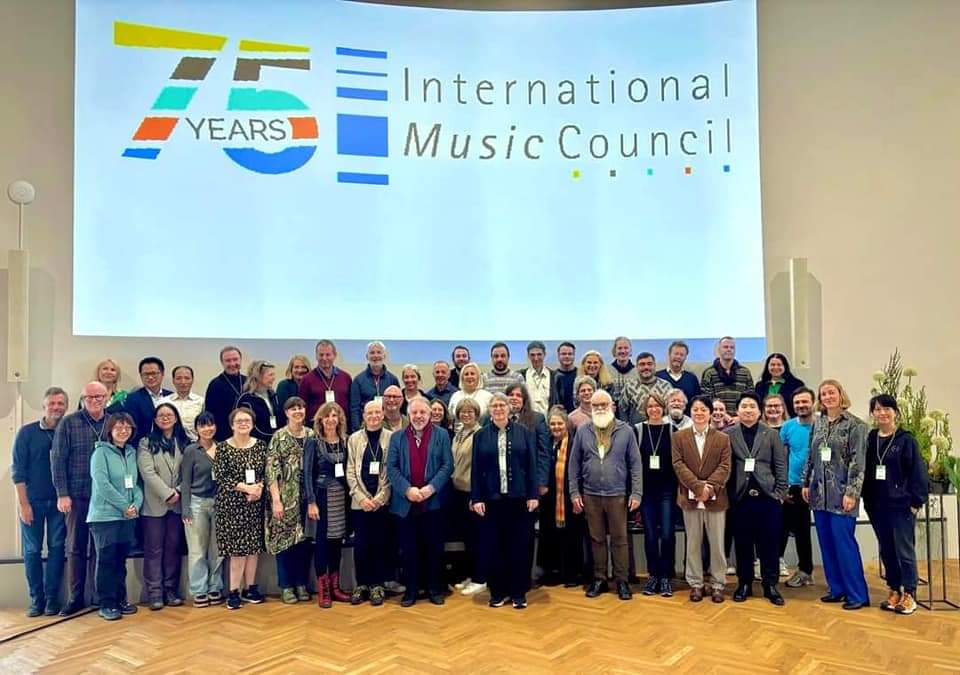
The day was far from over with the last concert at 9pm, but continued with late-night conversations over super-expensive glasses of beer (which is the cheapest drink in the pub). The days were long because the day itself is so long in the Faroe Islands, and if even the birds sleep and live with the rhythm of light to sing and experience summer to the full, so do the festival guests experience every moment of togetherness.
Concert venues. Tunnel and vodka.
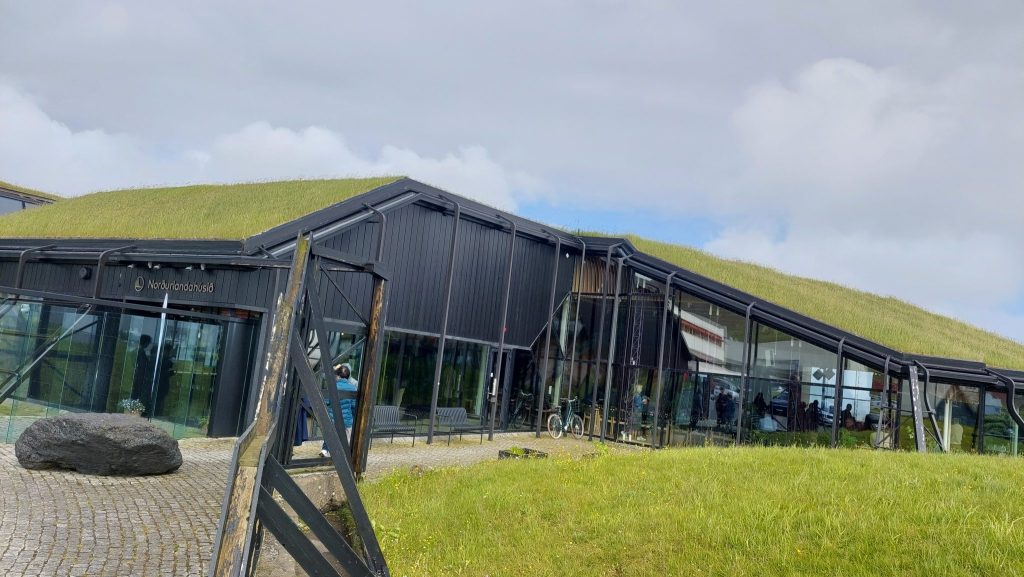
One of the central concert venues, the Nordic House or Norðurlandahúsið, with a grass roof, like many buildings in the Faroe Islands, is literally built into a rock. The Tórshavn Music School is a comfortable building equipped with new instruments. There was also a new concert hall, Varpið, in Klaksvík on Borðoy island. There were also more unconventional concert venues like miniature wooden churches, jazz bars and clubs. The concerts were not only indoors but also outdoors, which I was doubtful about at first because we know that the Faroe Islands have at least 270 rainy days a year, but we were very lucky to have a sound walk in Tórshavn Park and a concert in Gjógv rock grotto without rain. I felt that the park played a key role in the sound walks, especially the trees, which sometimes resembled plants from our latitudes, sometimes Arctic wildflowers, and sometimes, like from an exotic island, huge fuchsia bushes. This is the advantage of such performances dispersed in space – attention flows in and out.

The tunnel under the Atlantic Ocean to the island of Sandoy was a very peculiar and exotic concert venue. In the Faroe Islands there are many tunnels connecting the islands under the ocean, and in one of these tunnels a sound installation by Sunleif Rasmussen was played, or more accurately, background music, which was broadcast on certain radio frequencies in a car, in our case a bus. So, as we drove through this particular tunnel at 70 km per hour, there was music, the sound quality of the bus was quite variable, but the process was unique.
We didn’t get to hear the acoustics of the tunnel, but we did see colourfully illuminated art objects, one of which is in a circle, which is a rarity in tunnels. Plus vodka was served before entering the tunnel, along with a story by Sunleif Rasmussen about its special recipe. The tunnel excavation revealed a water reservoir deep under the ocean floor. Since this water is rich in minerals and has an unusual taste, it was decided to make vodka from it.
Kristian Black and Concerto Grotto
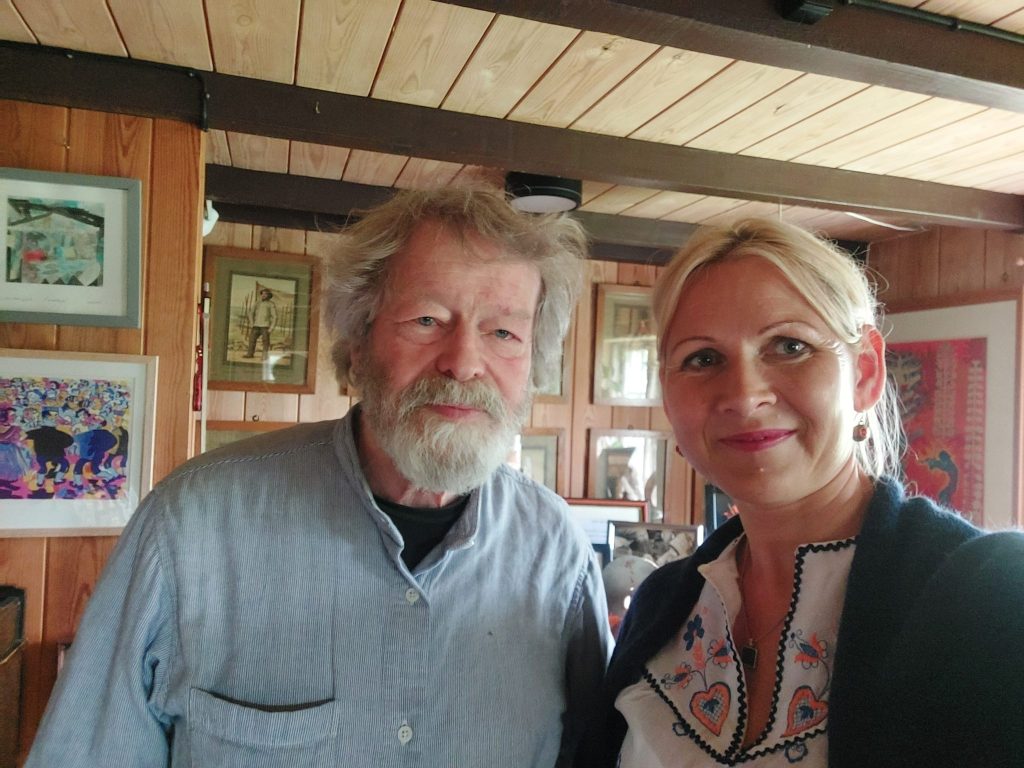
Kristian Blak is the heart and soul of Faroese culture and musical life. Kristian is a jazz pianist, composer, head of TUTL Records and artistic director of the Summartónar festival. He plays a wide variety of folk instruments, collaborates with many musicians, as well as ethnomusicians from all over the world. It was he who came up with the idea of bringing the WNMD festival to the Faroe Islands, and at the last minute, two years ago. Membership in the ISCM has given Faroese music a much wider global exposure. Kristian Black’s music was heard several times at the festival, both his own improvisations with the band Yggdrasil and classically composed originals that seemed very Faroese – harmonically dense and sometimes sentimental.
I went to Kristian’s house in the old town of Tórshavn, tucked into a hilltop and covered with rocks. The cosy study is home to a myriad of musical instruments, a testament to musical friendships across continents. The door of the house is unlikely to be locked, as this has not been a necessity in the Faroe Islands, except perhaps in recent years. If a traveller knocks on the door, shelter, warmth and food are offered without a word, a historical tradition because of the harsh climate. This custom is deeply rooted in people’s attitudes, traditions and unexaggerated kindness.
Anna Veismane: How long have you lived in the Faroe Islands, and why did you move here from Denmark?
Kristian Black: I have lived in this house since 1975. I lived in one room for the first year, but it was difficult to play and compose, so I looked for a house. We found it here in the old town. It was quite cheap, because it didn’t seem special or modern at the time. Later we extended the old house, just this studio with a piano and instruments.
AV: Why the Faroe Islands? Is this where you met your love?
KB: My wife? She’s in the next room, but no, she was born in America, and later we met through music. I immediately organised a band here and started teaching at the high school. It wasn’t like I was looking for a job, because I had been teaching music in Denmark, and I was also involved in sailing and shipbuilding.
AV: Really?
KB: Yes, I had a schooner. Music wasn’t my only occupation, but also athletics at national level. I wanted to change my environment and it was so interesting here! Lots of ideas and lots of fun. I could expand musically. So I stayed. I came with my knowledge of music, my interest in jazz, which was not at all common in the islands, and I felt that I could expand the musical life here in different ways. I wasn’t that big of a jazz specialist, but when I was studying in Aarhus, Denmark I was always interested in jazz, I went to concerts regularly. In the first years we started a trio – a guitarist, a bass player and me at the piano. After a few years there was already a big group of musicians to play with. There were musicians here before, but they played folk music, not jazz.
AV: The folk music tradition is still very strong. In almost every work by a Faroese composer I hear a direct or indirect reference to folk music, sometimes it’s a sense of harmony or a wistful sentiment. Is there something unique in this expression, do you think?
KB: Yes, it is. In my music I’ve always been drawn to the classical tradition and folk music, world music and of course jazz, and that’s because I play in different bands. Soon I will celebrate my 50th anniversary in music with concerts here in Denmark and in Italy. I was originally a musician, a pianist; composing came later when the jazz club opened. I started to write jazz compositions in a Nordic style, thinking about nature, also using modal harmony that is typical of Faroese music. In my band Ygrdrassil I decided to include rock guitar and musicians from all over the world. It was difficult at first to mix different styles in one vessel, but after a few years it became homogeneous. I know that at first the musicians didn’t feel so comfortable.
AV: Was there a tradition of playing concerts in grottoes, caves? Did you discover these venues because of the special acoustics?
KB: No, there was nothing like that before. It started as an experiment, but later it was a very important discovery. Forty years ago we had the first concert in the Faroese caves; it was very difficult to organise. The first experiment was composing with pre-recorded sounds of wind, water, ocean and birds, but playing and listening to the ocean and wind on the spot – in nature – is a completely different thing. It’s even more spectacular! Because we don’t talk when we listen to music, hearing is sharpened for any kind of sound. Remember the concert in Gjógv? We were listening to music, the ocean, and the wind at the same time.
Once a captain took us to one of these places, but he said there were much bigger grottoes, and he showed us a cave in Hestur as big as a cathedral, 200 metres deep, 50 metres high. There is a very long echo. Unfortunately, such trips have become very expensive. There used to be two concerts a week, and at least 20,000 people attended these cave concerts, or ‘Concerto Grotto’, as we call it.
AV: I’ve been thinking about how improvisation happens, is it more intuition or thinking and experience?
KB: It’s very interesting because every time the process is different. Sometimes I improvise in one tuning and suddenly I feel – enough! I’m tired! Even if others keep playing the same thing, I prefer a different direction, but I never plan it. It is important to stay focused.
AV: Is harmony important in your music?
KB: Yes, and different scales, modality. But even more the chords, chord sequences, shifts, major or minor chords, so one tonality doesn’t exist anymore.
AV: And singing? As an expressive expression?
KB: Yes, yes! I had forgotten about singing! I was listening to some recordings with Vera [Kondrateva] the other day and I remembered how I used to imitate barking dogs. Now at the concert I thought I should do something like that again. A spontaneous idea and the joy of creation!
Sunleif Rasmussen. First professional Faroese composer
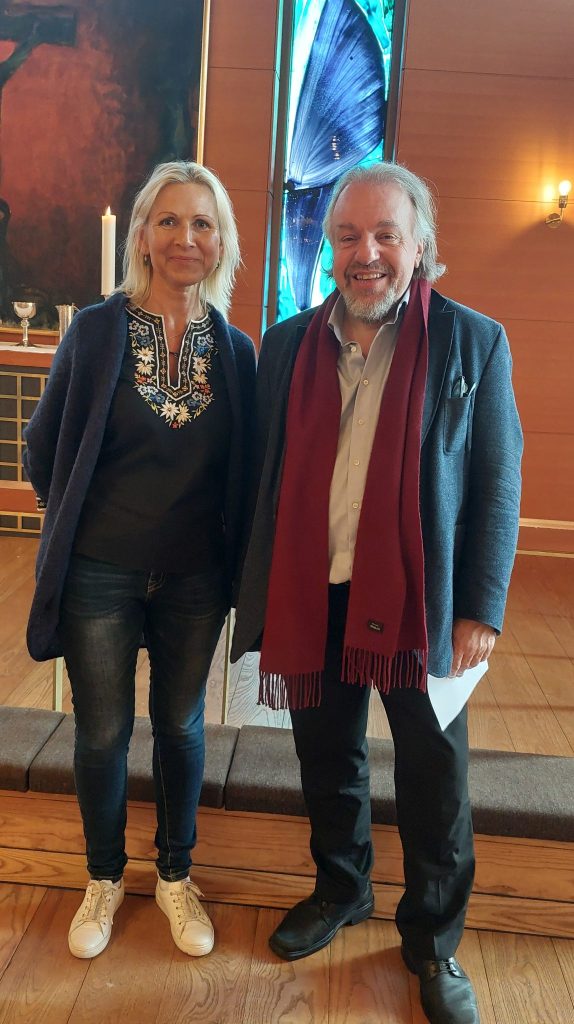
Knowing that I would be meeting Sunleif Rasmussen in the Faroe Islands, composer Indra Riše, who once studied with him at the same time at the Royal Danish Academy, added that they both have the “farmer gene”: “Sunleif tends his own flock of sheep on Sandoy, while I plant a forest! Is there another composer in Latvia who plants a forest?” Obviously, planting trees (which more than one composer and musician does) and planting a forest are two different things, but let’s talk about sheep later.
Sunleif Rasmussen received his initial musical training in Norway and later studied composition at the Royal Danish Academy of Music in Copenhagen with Ib Nørholm and electronic music with Ivar Frounberg. He has received numerous international awards, including the Nordic Council Music Prize for his Symphony No.1 Oceanic Days and the Faroese Cultural Honorary Award. Sunleif Rasmussen is the Artistic Director of the 2024 ISCM World New Music Days, so we met at the crossroads of the festival – the Nordic House.
Anna Veismane: How did you choose the works for the ISCM World New Music Days?
Sunlaif Rasmussen: I programme concerts according to my experience – for example, I don’t like long concerts, so I do 50-minute concerts without an intermission. I like to combine different genres, different aesthetics, otherwise it gets boring. And, as I’ve heard from the local audience, people really like it.
AV: Were musicians involved in the selection process?
SR: Yes, but first I selected the pieces myself, and in this case I did it alone because the community of musicians in the islands is small, I chose about 70 minutes of music – that’s more than the concert needs – and the musicians decided on their favourites. So yes, they were involved in the programming, the ensembles like to think about the concept of the concert as well.
AV: You’ve probably been asked many times if Faroese composers have a common identity. I noticed that there is a strong presence of folk music, also a certain sentiment.
SR: Yes, indeed! (laughs)! I am a teacher of many Faroese composers at the Tórshavn School of Music, at the secondary school, before going to conservatoire in Denmark or elsewhere abroad, which would be the next level. I never try to point anyone in a particular direction – everyone has to find their own voice. On the contrary, I try to encourage you to find who you are. That’s how I was brought up at the Royal Danish Academy of Music. Ib Nørholm and Ivar Frounberg were teachers who never showed their music as an example. I would never want one of my pupils to be Sunleif Rasmussen I or Sunleif Rasmussen II.
AV: Did you meet Indra Riše in Copenhagen?
SR: Yes, we studied at the same time.
AV: You were born on the island of Sandoy, how did you become a musician and later a composer?
SR: Nobody in my family was a musician. My mother’s family were farmers since the Middle Ages (laughs), on my father’s side – fishermen. My grandmother’s brother was a well-known writer in the Faroe Islands and became my mentor. Despite the two-generation difference, we had fruitful discussions about art. When I was initiated at the age of 14, I received gifts as one does on such occasions and I bought myself a piano. I started to educate myself, met young aspiring musicians like me, and we formed a rock band. When I bought the piano, my grandmother, whose grandfather was a writer, confessed that she used to study organ in Tórshavn and she had an organ book in Swedish, of chorales. I couldn’t read Swedish, but I tried to play the notes. At the age of 18, I went to Norway where I studied theory and proper piano playing. I practised a lot, even 12 hours a day for a whole year.
AV: When you compose, do you still play the piano?
SR: Before composing, yes, when I’m looking for some musical material. But once I really start writing, definitely not. Then the piano gets in the way of the imagination.
AV: If you could freely choose what to write and for whom, what would it be?
SR: If you’re a composer, you have to love all the instruments, otherwise it’s difficult. When I get a commission, it’s a pleasure to discover something new every time, to discover new sounds, new colours of instruments. In that sense I’ve been lucky, because I’ve had many commissions and performances. But if I think about it, I would like to write an opera.
AV: Is it important for you to do different things – compose, play, organise, teach? How can you combine these different activities? Most composers are introverted people.
SR: I have both sides. I like to be with myself, but I’m also quite extroverted. And living in a small society like the Faroe Islands, you can’t just do one thing – then nothing happens. As the first professional Faroese composer, I feel a responsibility to share my knowledge, so I teach. That was the reason why I took on the WNMD festival – to bring contemporary music from all over the world to the local community, including musicians.
AV: You have a flock of sheep. Do you know any other composers in the world who have sheep?
SR: No, I don’t! (laughs) I’ve had the idea for a long time to record sheep voices and include them in a piece. When I was with the recorder player Michala Petri, we rented a house by the ocean: when she practised, the birds sang along and even the seals responded from the ocean! That’s the beauty of the islands.
